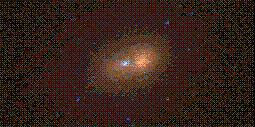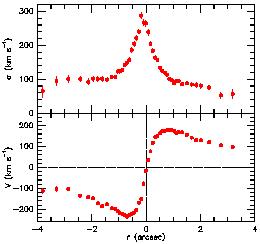


3.3 M 31: MBH
 3 x 107
M
3 x 107
M
M 31 is the highest-luminosity galaxy in the Local Group. At a distance of 0.77 Mpc, it is the nearest giant galaxy outside our own. It can therefore be studied in unusual detail.
M 31 contains the nearest example of a nuclear star cluster embedded in a normal bulge. When examined with HST, the nucleus appears double (Figure 3). This is very surprising. At a separation of 2r = 0".49 = 1.7 pc, a relative velocity of 200 km s-1 implies a circular orbit period of 50,000 yr. If the nucleus consisted of two star clusters in orbit around each other, as Fig. 3 might suggest, then dynamical friction would make them merge within a few orbital times. Therefore it is unlikely that the simplest possible explanation is correct: we are not observing the last stages of the digestion of an accreted companion galaxy.
The nucleus rotates rapidly and has a steep velocity dispersion gradient
(Figure 3). Dynamical analysis shows that
M 31
contains a central dark mass
MBH  3 x
107
M
3 x
107
M .
The possible effects of velocity
anisotropy have been checked and provide no escape. Furthermore, the asymmetry
provides an almost independent check of the BH mass, as follows.
.
The possible effects of velocity
anisotropy have been checked and provide no escape. Furthermore, the asymmetry
provides an almost independent check of the BH mass, as follows.
The top panel of Figure 3 shows the HST
image at the same scale as
and registered in position with the kinematics. It shows that the dispersion
peak is approximately centered on the fainter nucleus. In fact, it is centered
almost exactly on a cluster of blue stars that is embedded in this nucleus.
This suggests that the BH is in the blue cluster. This hypothesis can be tested
by finding the center of mass of the asymmetric distribution of
starlight plus a
dark object in the blue cluster. The mass-to-light ratio of the stars is
provided by dynamical models of the bulge at larger radii. If the galaxy is in
equilibrium, then the center of mass should coincide with the center of the
bulge. It does, provided that MBH
 3 x 107
M
3 x 107
M .
Remarkably, the same BH mass explains the kinematics and the asymmetry of the
nucleus.
.
Remarkably, the same BH mass explains the kinematics and the asymmetry of the
nucleus.
An explanation of the mysterious double nucleus has been proposed by
Scott Tremaine. He suggests that both nuclei are part of a single eccentric
disk of stars. The brighter nucleus is farther from the barycenter; it results
from the lingering of stars near the apocenters of very elongated orbits. The
fainter nucleus is produced by an increase in disk density toward the center.
The model depends on the presence of a BH to make the potential almost
Keplerian; then the alignment of orbits in the eccentric disk may be maintained
by the disk's self-gravity. Tremaine's model was developed to explain the
photometric and kinematic asymmetries as seen at resolution
 *
*
 0".5. It is also consistent with the data in Figure 3
(
0".5. It is also consistent with the data in Figure 3
( *
*
 0".27). The high velocity dispersion near the BH, the low dispersion in the
offcenter nucleus, and especially the asymmetric rotation curve are signatures
of the eccentric, aligned orbits.
0".27). The high velocity dispersion near the BH, the low dispersion in the
offcenter nucleus, and especially the asymmetric rotation curve are signatures
of the eccentric, aligned orbits.
Most recently, spectroscopy of M 31 has been obtained with the HST Faint Object Camera. This improves the spatial resolution by an additional factor of ~ 5. At this resolution, there is a 0".25 wide region centered on the faint nucleus in which the velocity dispersion is 440 ± 70 km s-1. This is further confirmation of the existence and location of the BH.

|

|
Figure 3. (top) HST WFPC2
color image of M 31
constructed from I-, V- and 3000 Å-band,
PSF-deconvolved images obtained by Lauer et al. (1998,
Astron. J., 116, 2263).
The scale is
0".0228 pixel-1. (bottom and middle) Rotation curve
V(r) and velocity dispersion profile
|
We do not know whether the double nucleus is the cause or an effect of the offcenter BH. However, offcenter BHs are an inevitable consequence of hierarchical structure formation and galaxy mergers. If most large galaxies contain BHs, then mergers produce binary BHs and, in three-body encounters, BH ejections with recoil. How much offset we see, and indeed whether we see two BHs or one or none at all, depend on the relative rates of mergers, dynamical friction, and binary orbit decay. Offcenter BHs may have much to tell us about these and other processes. Already there is evidence in NGC 4486B for a second double nucleus containing a BH.